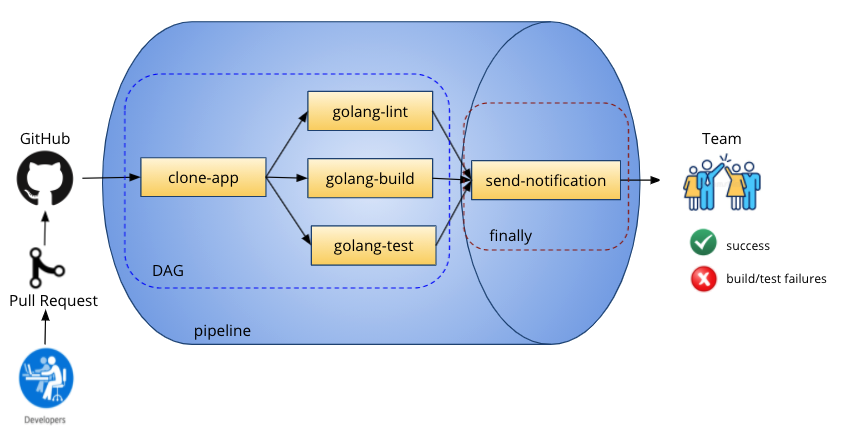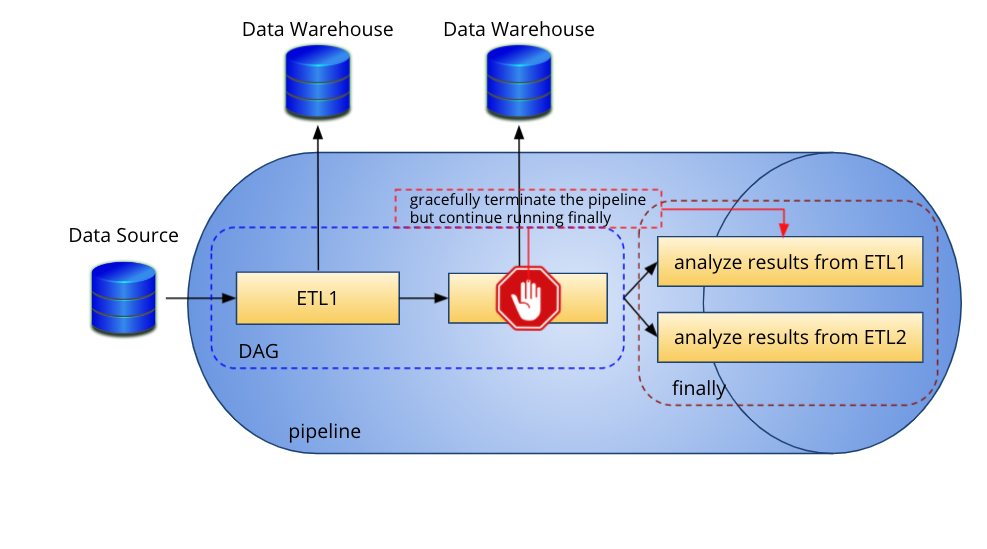

Add finally tasks to Tekton pipelines
source link: https://developer.ibm.com/blogs/add-finally-to-tekton-pipelines/
Go to the source link to view the article. You can view the picture content, updated content and better typesetting reading experience. If the link is broken, please click the button below to view the snapshot at that time.

Add finally tasks to Tekton pipelines – IBM Developer
IBM Developer Blog
Follow the latest happenings with IBM Developer and stay in the know.
Tekton Pipeline 0.14 introduced the finally clause in the Pipeline specification. This section is ideal for running anything just before exiting the pipeline, such as cleaning up any acquired resources, sending notifications, rolling back deployments, and more.
As defined on the Tekton website, the finally section takes a list of one or more tasks that are all executed in parallel after all tasks are finished executing — regardless of a success or a failure. The following code shows the finally section of a pipeline.
apiVersion: tekton.dev/v1beta1
kind: Pipeline
metadata:
name:build-deploy-cleaup-pipeline
spec:
params:
- name: api-url
- name: cloud-region
tasks:
- name: clone
taskRef:
name: git-clone
- name: build
taskRef:
name: build
runAfter:
- clone
- name: deploy
taskRef:
name: deploy
runAfter:
- build
finally:
- name: cleanup
taskRef:
name: cleanup
Also, the execution status of a finally task affects the overall pipelineRun status. A pipelineRun is declared failed if one or more finally tasks fail.
The community has implemented many features over the past few releases to help design finally tasks for common use cases.
Use cases for finally
A Tekton Pipeline is implemented as a Kubernetes controller and executes a collection of pods on your Kubernetes cluster. You can configure a pipeline using a directed acyclic graph (DAG) and a set of finally tasks based on your continuous integration and continuous delivery (CI/CD) workflow. The most common workflow for CI/CD is build-test-deploy, which we extend here to include finally scenarios.
Send notification
As the following image shows, a CI/CD pipeline defines a finally task named send-notification that references send-to-channel-slack and/or sendmail to notify the team and sends a success or failure notification depending on the execution status of the build process. The build process includes build and test tasks in the tasks section of the pipeline.

Cleanup resources
A couple of cleanup scenarios:
A pipeline creates a project or acquires resources and sends the name of the project or resources to the
finallytask. Thefinallytask can then clean up those project resources regardless of a failure in thetaskssection, as shown in the following image:
A pipeline provisions a new Kubernetes cluster. The pipeline starts executing and stops for some reason. The pipeline has defined
finallytasks to free up the Kubernetes cluster. Even though thepipelineRunstops, thefinallysection executes to free up the resources.
Terminate rather than cancel
You are running a pipeline that executes a few Extract, Transform, and Load (ETL) processes in a sequence, as shown in the following image. Because of resource constraints, you want to cancel scheduling any further processes but compelete executing the current running process and analyze the results from that process, as shown in this image:

These are the most common use cases that require the functionality of finally or an exit handler in a pipeline. Next, let’s look at the list of the features that we introduced to accomplish these use cases.
Use finally with if
The finally tasks are guaranteed to execute before the pipelineRun exits. However, there are use cases where the pipeline needs the flexibility to not run a finally task based on a certain condition (for example, the user wants to send a Slack notification only if a build fails). We have implemented two features to make this use case possible: TEP-0045 and TEP-0028 have the details. The overall idea here is to enable specifying when expressions in a finally task and provide a means to access the execution status of a task in a finally task at runtime so that you can evaluate specified when expressions. You can access an execution status of a task using a context variable $(tasks.<task-name>.status):
spec:
pipelineSpec:
tasks:
- name: golang-build
taskRef:
name: golang-build
- name: unit-test
taskRef:
name: golang-unit
runAfter: [ golang-build ]
- name: deploy
taskRef:
name: deploy
runAfter: [ unit-test ]
finally:
- name: notify-build-failure
when:
- input: $(tasks.golang-build.status)
operator: in
values: ["Failed"]
taskRef:
name: send-to-slack-channel
Now, instead of notifying only for a build failure, you want to send a Slack notification for any failure. TEP-0049 implements accessing an aggregate status of the tasks section in finally using a context variable $(tasks.status):
spec:
pipelineSpec:
...
finally:
- name: notify-any-failure
when:
- input: $(tasks.status)
operator: in
values: ["Failed"]
taskRef:
name: send-to-slack-channel
Connect tasks and finally sections
If you are a pipeline author, you can now send the execution results of a task to any finally task so that the project resources created/acquired by the pipeline are guaranteed to be cleaned up by the finally task. TEP-0004 explains the design details of this feature.
spec:
tasks:
- name: acquire
taskRef:
name: acquire
finally:
- name: release
taskRef:
name: release
params:
- name: leased-resource
value: $(tasks.acquire.results.leased-resource)
Gracefully terminate a pipeline
Rafal Bigraj spent a lot of effort in designing and implementing a feature (TEP-0058), which made one of the common machine learning use cases possible using Tekton.
We implemented a solution to enable graceful termination (cancellation) of a pipeline where the current running tasks are cancelled or terminated and the cleanup is scheduled. When a pipelineRun is executing, you can update its definition to cancel the tasks, which deletes all the respective pods and schedules the finally section.
apiVersion: tekton.dev/v1beta1
kind: PipelineRun
metadata:
name: etl-processes
spec:
status: "CancelledRunFinally"
We implemented one more solution where the current running tasks are not interrupted until they are finished and no new tasks are scheduled. After the current running tasks finish, the finally section is executed to analyze the results from already executed tasks.
apiVersion: tekton.dev/v1beta1
kind: PipelineRun
metadata:
name: etl-processes
spec:
status: "StoppedRunFinally"
Now you know how to design a finally section of a pipeline to implement various use cases. If you have a use case or need a new feature in Tekton, reach out to the Tekton community over Slack or open a discussion in the tektoncd/pipeline repo.
Recommend
-
 43
43
概况 Tekton 是一个功能强大且灵活的 Kubernetes 原生开源框架,用于创建持续集成和交付(CI/CD)系统。通过抽象底层实现细节,用户可以跨多云平台和本地系统进行构建、测试和部署。
-
 50
50
Tekton Pipelines The Tekton Pipelines project provides k8s-style resources for declaring CI/CD-style pipelines. Tekton Pipelines are Cloud Native : Run on Kubern...
-
 49
49
前言 Tekton Pipelines是一个开源实现,可为您的Kubernetes应用程序配置和运行CI / CD风格的管道。 Pipelines创建
-
 8
8
需要以更快速、可重复且一致的方式以及恰当的管理方法在生产环境中部署更多的机器学习模型。 在 2018 年 3 月举办的 Strata Data Conference 大会上,IBM 副总裁 Dinesh Nirmal 提到了机器学习梯队中的一个
-
 11
11
Getting started with Tekton and Pipelines
-
 11
11
Sample Tekton Pipelines for Microservices This article describes how microservices can be deployed via Tekton on OpenShift. A sample application is used which you can try yourself. Application modernization pr...
-
 4
4
Accessing GitHub in Tekton Tasks on OpenShift This article explains how to access GitHub repositories from Tekton tasks on behalf of specific users via ssh. In my
-
 8
8
Real-time debugging in Tekton pipelines Skip to main content Debugging
-
 3
3
Tekton without Tekton in DevSecOps Pipelines IBM provides a DevSecOps reference implementation which is especially useful for regulated industries to adhere to policies. This article describes how we...
-
 9
9
About Joyk
Aggregate valuable and interesting links.
Joyk means Joy of geeK